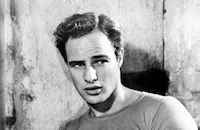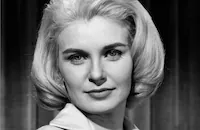Marlon Brando got the opportunity to play a role written for him by one of America's greatest playwrights and lived to regret it. He even took the film against his better judgment. Although The Fugitive Kind (1959) provides a fascinating footnote in Williams' career, the character of drifter Val Xavier, who ignites the passions of three women in a corrupt Mississippi town, marked the beginning of a long box-office decline for Brando.
The Fugitive Kind marked the third incarnation of Williams' fascinating mix of Greek mythology, Christianity and Freudian psychology. He had started working on the play under the title Something Wild in the Country in the '30s, hoping to interest stage star and fellow Southerner Tallulah Bankhead in the role of a woman trapped in a loveless marriage who has an affair with a magnetic young drifter. Though she thought the as yet untested playwright showed talent, she also felt the strange mixture of religion and sex wouldn't work for audiences of the era. She was proven right when the Theatre Guild produced the work, now titled Battle of Angels in a Boston tryout in 1940, with Miriam Hopkins starring. Although legend has ruled that production an unmitigated disaster, it actually got respectable reviews, particularly from more serious critics like Alexander Woollcott and Elliot Norton. But the production's size, numerous audience walkouts and an unwieldy climactic fire that at one performance got out of control, forcing the remaining patrons to evacuate the theatre, convinced the Guild to close the show out of town.
Williams never gave up on what he would call his most personal play. After establishing himself as a major playwright with such hits as The Glass Menagerie and A Streetcar Named Desire, he re-wrote Battle of Angeles as Orpheus Descending. He had hoped to team Marlon Brando and Anna Magnani in the stage production, even turning the leading lady into an Italian immigrant. But Magnani refused to commit to anything longer than a two month run, and Brando decided he wanted to focus entirely on screen work. In addition, he was far from pleased with the script and thought the leading lady's role had much more weight than his. The play opened in March 1957 with Maureen Stapleton and Cliff Robertson in the leads. Thanks largely to negative reviews, it closed in less than two months, becoming the author's first major flop with both critics and audiences.
Still, even an artistic failure by Tennessee Williams was thought to have box office potential in Hollywood. With adaptations of Cat on a Hot Tin Roof (1958) and Suddenly, Last Summer (1959) in preparation at other studios, independent producers Martin Jurow and Richard A. Shepherd optioned the play and even got Williams to co-write the screenplay with young playwright Meade Roberts. They secured promising young director Sidney Lumet, fresh from a string of impressive television dramas and the acclaimed 12 Angry Men (1957), to direct. More important to Williams, however, was their willingness to offer the leads to Magnani and Brando.
Brando was still not thrilled with the material, but he had other problems that made the offer more attractive. He had just finished directing his first film, the Western One-Eyed Jacks (1961), and his slow pace had put his production company, Pennabaker Films, seriously into the red. At the same time, his father's attempts to invest the star's earnings in a ranch had cost him over $1 million, and he was going through a costly divorce from actress Anna Kashfi. When the producers dangled a $1 million pay check, the largest sum ever paid an actor for a single role, and agreed to release The Fugitive Kind through United Artists as a Pennabaker production, it was an offer he couldn't refuse.
Magnani also signed on, and Joanne Woodward was so taken with the role of a hard-drinking female rebel she told the producers she'd do anything to keep another actress from playing it. Since this was the second Williams role Stapleton had lost to Anna Magnani, nobody considered offering her one of the film's many supporting roles. When she heard they wanted to use her but were afraid to call, Stapleton called the producers herself and said she'd be glad to play the smaller role of the sheriff's wife, an artistic visionary who goes blind after meeting Brando's character but finds her calling as a painter nonetheless.
Over the years, Lumet has done his best work with portraits of men in crisis, from the unnamed juror in 12 Angry Men to the cop-informant in Serpico (1973) and, most recently, the morally bankrupt businessman in Before the Devil Knows You're Dead (2007). That should have made him the ideal director to strengthen the role of Val in The Fugitive Kind, but during rehearsals he couldn't come up with any ideas that fit the playwright's vision. Williams' gift for creating compelling female characters was so strong that as soon as Val met Lady Torrance (Magnani), the film became about her.
Compounding the script problems were Lumet's difficulties finding a common ground with his leading lady. Lumet usually insisted on two weeks of rehearsal before filming, but Magnani was used to working in real locations in her native Italy; the rehearsal hall -- where folding chairs stood in for walls, doors and anything else required by the script -- was a foreign land to the actress. She had so much trouble he had to abandon his usual practice of running the script entirely during the last few days of rehearsals.
Magnani also had problems with Brando. Early on, Williams had warned the actor that his leading lady had a crush on him. From their first meeting, she insisted that they needed to get together in private to discuss the film. He finally agreed to meet with her, at which point she put the moves on him. When she refused to stop kissing him, even biting his lip painfully to keep him close, he had to squeeze her nose to make her let go. When filming started, the two clashed frequently over everything from dressing rooms to billing (he got top billing in the U.S.; she got it in Italy) and interpretation. He also started mumbling during shooting and rehearsals, which made it very hard for an actress who barely spoke English to pick up her cues. It made it hard on the other actors as well, and Stapleton, who had known Brando since his early days in the theatre, finally took him aside to ask him to speak up.
Rather than face the temperatures in Mississippi or risk getting caught up in the then-exploding racial tensions in the South, Lumet shot The Fugitive Kind on location in Milton, New York, with studio work in the Gold Key Studios in Brooklyn. This also allowed him to stay closer to his beloved New York City, while making it possible to fill the supporting cast with stage actors like John Baragrey, Virgilia Chew, Sally Gracie and Lucille Benson.
When The Fugitive Kind opened in 1960 it was a box-office disaster. Although Lumet and Woodward were honored for their work at the San Sebastian Film Festival, most U.S. critics felt the movie was a misguided effort, comparing it unfavorably to earlier screen adaptations of Williams' plays. Variety labeled it "Exploitable but still a questionable box office entry," while the New Republic's Stanley Kauffman wondered, "Is there a future for Tennessee Williams? Or is there nothing ahead of him but the past?" That was nothing compared to the conservative Films in Review, which labeled the film "a disgrace to US culture...nothing but the malevolence of a spiteful and undisciplined child shrieking lies about its elders." More recent critics have reevaluated the film in light of Lumet's career and pointed out the solid work of cinematographer Boris Kaufman, a frequent collaborator during the director's early years, and composer Kenyon Hopkins.
At the time, however, The Fugitive Kind was written off as a disaster, with only Stapleton generating consistently good reviews. With the failure of One-Eyed Jacks and his time-consuming behavior on 1962's Mutiny on the Bounty, Brando's career went into a slump that lasted until his comeback as Don Vito Corleone in The Godfather (1972). The Fugitive Kind and One-Eyed Jacks also forced him to turn down the film that might have prevented that slide, Lawrence of Arabia (1962). The Fugitive Kind also cooled his friendship with Williams. Each accused the other of being fixated on Stanley Kowalski, Brando's star-making role in the playwright's A Streetcar Named Desire (1951). Brando claimed the playwright had wanted the same performance in their second collaboration, while Williams accused Brando of mumbling his way through the film in an attempt to play the more poetic Val Xavier like his earlier, more animalistic role.
Yet Orpheus Descending would live on. In 1988, Vanessa Redgrave starred in a successful London revival of the play. A year later she took the production to New York to further acclaim, and in 1990 she filmed it for Turner Network Television with a cast combining members of both earlier productions, including Kevin Anderson as Val, Anne Twomey in Woodward's role and Miriam Margolyes as the sheriff's wife. For the first time, Orpheus Descending was a hit, and the productions' success led to a critical reevaluation of the work.
Producer: Martin Jurow, Richard Shepherd
Director: Sidney Lumet
Screenplay: Meade Roberts, Tennessee Williams
Based on Williams' play Orpheus Descending
Cinematography: Boris Kaufman
Art Direction: Richard Sylbert
Music: Kenyon Hopkins
Cast: Marlon Brando (Val Xavier), Anna Magnani (Lady Torrance), Joanne Woodward (Carol Cutrere), Maureen Stapleton (Vee Talbot), Victor Jory (Jabe Torrance), R.G. Armstrong (Sheriff Talbot), Sally Gracie (Dolly Hamma), Lucille Benson (Beulah Binnings).
BW-121m.
by Frank Miller


























